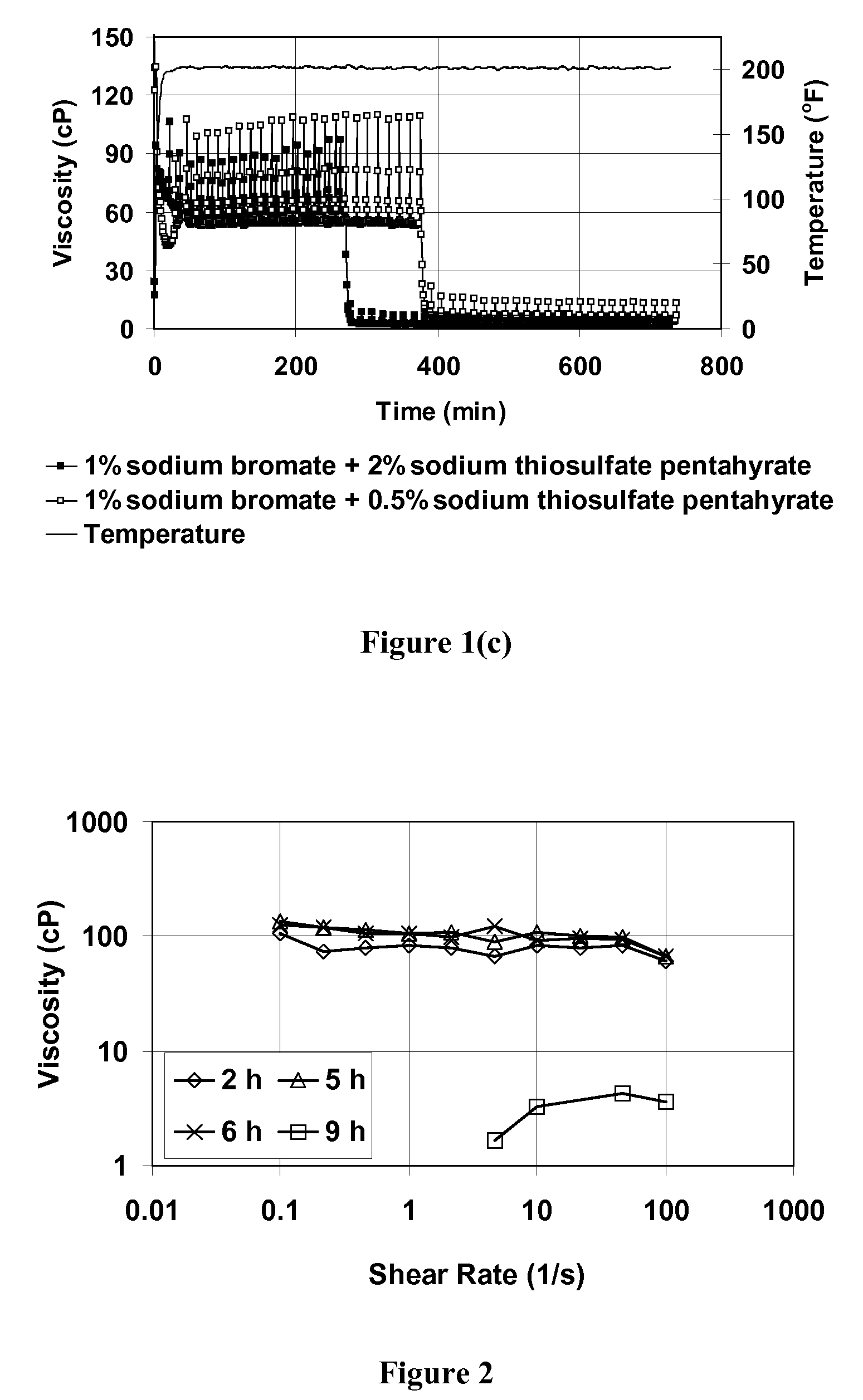Oxidative internal breaker system with breaking activators for viscoelastic surfactant fluids
a technology of viscoelastic surfactant fluid and activator, which is applied in the field of recovery of oil and gas from wells, can solve the problems of limited interaction between the activator and the ves fluid, and achieve the effect of losing viscosity
- Summary
- Abstract
- Description
- Claims
- Application Information
AI Technical Summary
Benefits of technology
Problems solved by technology
Method used
Image
Examples
example 1
Sodium Bromate+Sodium Thiosulfate in 2 wt % KCl Brine at 93.3° C. (200° F.)
[0072]This example demonstrates that sodium thiosulfate acts as an activator for sodium bromate to break VES fluid, allowing breaking to occur at relatively low temperatures. FIG. 1 shows a plot of viscosity at 93.3° C. (200° F.) as a function of time for VES fluids containing 4 vol % BET-E-40, 2 wt % KCl, 1 vol % 2-butoxyethanol. The plot designated (a) shows VES with no other additive; (b) shows a similar plot of VES fluid with either 1 wt % sodium bromate or 1 wt % sodium thiosulfate pentahydrate; and (c) shows a similar plot with 1% sodium bromate and 2 wt % or 0.5 wt % sodium thiosulfate pentahydrate. This figure demonstrates that when either sodium bromate or sodium thiosulfate alone is added to the VES fluid, minimal viscosity change is observed compared with that for the base fluid. However, when both the bromate and thiosulfate salts are mixed together with the fluid, complete viscosity reduction occ...
example 2
Sodium Bromate+Sodium Thiosulfate in 2 wt % KCl Brine at 79.4° C. (175° F.)
[0074]FIG. 3 illustrates that sodium thiosulfate can activate the reaction of sodium bromate at even lower temperatures of 79.4° C. (175° F.). Compared with FIG. 1(c), FIG. 3(c) shows that the break time not only can be controlled by variation of the concentration of the activator, and / or breaker, but also by the temperature. Decreasing the fluid temperature to 175° F. leads to increased delay time before the breaking occurs.
example 3
Sodium Bromate+Sodium Thiosulfate in NaBr Brine at 93.3° C. (200° F.)
[0075]This example shows that the unique chemistry of combining sodium bromate and sodium thiosulfate offers well controlled breaking of VES fluids prepared in heavy brines. In this example, experiments were carried out in sodium bromide brine with a density of 1.427 g / ml (11.9 lbm / gal). The base fluid remains stable during the test time frame of 14 hours as shown in FIG. 4 (a). Similar to the data described in Example 1 for unbrined VES fluid, sodium bromate or sodium thiosulfate alone can not break the brined VES fluid. FIG. 4(c) illustrates that when these two salts are both present, complete breaking occurs with hours of delay time.
[0076]FIG. 5 shows that the breaking may also be observed at low shear rates, similar to the breaking in 2% KCl brine.
PUM
| Property | Measurement | Unit |
|---|---|---|
| wt % | aaaaa | aaaaa |
| temperatures | aaaaa | aaaaa |
| temperatures | aaaaa | aaaaa |
Abstract
Description
Claims
Application Information
 Login to View More
Login to View More - R&D
- Intellectual Property
- Life Sciences
- Materials
- Tech Scout
- Unparalleled Data Quality
- Higher Quality Content
- 60% Fewer Hallucinations
Browse by: Latest US Patents, China's latest patents, Technical Efficacy Thesaurus, Application Domain, Technology Topic, Popular Technical Reports.
© 2025 PatSnap. All rights reserved.Legal|Privacy policy|Modern Slavery Act Transparency Statement|Sitemap|About US| Contact US: help@patsnap.com



